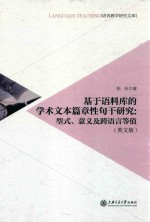
- 作 者:张乐著
- 出 版 社:上海:上海交通大学出版社
- 出版年份:2015
- ISBN:9787313139245
- 标注页数:265 页
- PDF页数:287 页
请阅读订购服务说明与试读!
订购服务说明
1、本站所有的书默认都是PDF格式,该格式图书只能阅读和打印,不能再次编辑。
2、除分上下册或者多册的情况下,一般PDF页数一定要大于标注页数才建议下单购买。【本资源287 ≥265页】
图书下载及付费说明
1、所有的电子图书为PDF格式,支持电脑、手机、平板等各类电子设备阅读;可以任意拷贝文件到不同的阅读设备里进行阅读。
2、电子图书在提交订单后一般半小时内处理完成,最晚48小时内处理完成。(非工作日购买会延迟)
3、所有的电子图书都是原书直接扫描方式制作而成。
Chapter 1 Introduction 1
1.1 Research Background 1
1.2 Objectives of this Book 4
1.3 Significance of this Book 5
1.4 Organization 6
Chapter 2 Literature Review 8
2.1 Pawley&Syder's Lexicalized Sentence Stem 8
2.2 Granger&Paquot's Textual Stentence Stem 12
2.3 Textual Stentence Stem and Evaluation 14
2.3.1 The Multifunctionality of TSSs 14
2.3.2 Research on Evaluation in Academic Writing 17
2.3.2.1 Hedging 18
2.3.2.2 Metadiscourse 20
2.3.2.3 Model of Interaction in Academic Discourse 23
2.3.3 Evaluation from a Cross-cultural Perspective 25
2.4 Corpus-driven Studies of Phraseology 28
2.4.1 The Firthian Tradition 29
2.4.2 Lexis and Grammar 30
2.4.3 Idiom Principle 31
2.4.4 Extended Unit of Meaning 33
2.4.5 Pattern Grammar:a New Approach to the Lexical Grammar 35
2.4.6 Corpus-driven Study of Cross-linguistic Equivalence 39
2.5 Summary 46
Chapter 3 Methodological Considerations 48
3.1 Research Questions 48
3.2 Corpora Used in this Book 49
3.2.1 The English Comparable Corpus:JDEST 49
3.2.2 The Chinese Comparable Corpus:MCC 51
3.2.3 The Parallel Corpus:JDPC 52
3.3 Analytical Concepts and Procedures 56
3.3.1 Defining TSS,Pattern and Lexical Sequence 56
3.3.2 Searching for TSSs 60
3.3.2.1 Cluster and N-gram 60
3.3.2.2 Phrase Frame 62
3.3.3 Describing Evaluation 65
3.3.4 Looking for Translations 69
3.3.5 Identifying Equivalents 70
3.3.6 Other Terminological Issues 71
3.4 Summary 72
Chapter 4 Overall Frequency Distribution of TSSs 73
4.1 Overall Frequency Distribution of TSSs across Patterns 73
4.2 Content Subject Patterns 75
4.3 Dummy Subject Patterns 79
4.4 Stability and Variability of TSSs 85
4.5 Summary 90
Chapter 5 Functional Characteristics of TSSs 91
5.1 Functional Taxonomy of TSSs 91
5.2 Cognitive Acts 94
5.3 Research Acts 104
5.4 Inference Acts 111
5.5 Attitude Marking 119
5.6 Hedging 126
5.7 Directive Acts 130
5.8 Intertextual Acts 135
5.8.1 Averral and Attribution 135
5.8.2 Categories of Intertextual Acts 136
5.8.3 TSS of Agentative Integral Citation 138
5.8.3.1 Tense of Reporting Verbs and Evaluation 138
5.8.3.2 A Special Case:the Unspecified Author 140
5.8.3.3 Two Layers of Evaluation in Attribution 143
5.8.4 TSSs of Non-agentative Integral Citation 151
5.8.5 TSSs of Identifying Non-integral Citation 152
5.8.6 TSSs of Non-identifying Non-integral Citation 156
5.9 Intratextual Acts 160
5.10 Discussion:Strategic Balancing in Academic Writing 162
5.11 Summary 169
Chapter 6 Cross-linguistic Equivalence of TSSs in English and Chinese 170
6.1 Preliminaries 170
6.2 Content Subject TSSs and Chinese Equivalents 173
6.2.1 pro v that 173
6.2.2 pro modal v that 175
6.2.3 n v that 178
6.2.4 n v-link that 181
6.3 Dummy Subject TSSs and Chinese Equivalents 183
6.3.1 Sentence-medial Chinese Equivalents 184
6.3.2 Sentence-initial Chinese Equivalents 189
6.3.2.1 it v-link v-ed that 189
6.3.2.2 it v-link adj that 193
6.3.2.3 it v-link adj to v that and it modal be v-ed that 195
6.3.3 Sentence-final Chinese Equivalents 196
6.4 Translation Units and Equivalence 201
6.4.1 Equivalence of Lexical Sequences 202
6.4.2 Equivalence of Patterns 202
6.4.3 Equivalence of TSSs 205
6.4.4 Equivalence of Phrases around a Node Word 208
6.5 Contextualizing Description and Translation 215
6.5.1 Levels of Context and Co-selection 215
6.5.2 Identifying Functions and Equivalence in Context 218
6.6 Cross-linguistic Equivalence:Possible New Light 231
6.6.1 New Light on ESP Teaching and Learning 231
6.6.2 New Light on Contrastive Lexical Studies 234
6.6.3 New Light on Lexicon Construction 234
6.7 Summary 236
Chapter 7 Conclusion 238
7.1 Major Findings 238
7.2 Implications 244
7.3 Limitations 247
References 249
Index 261
